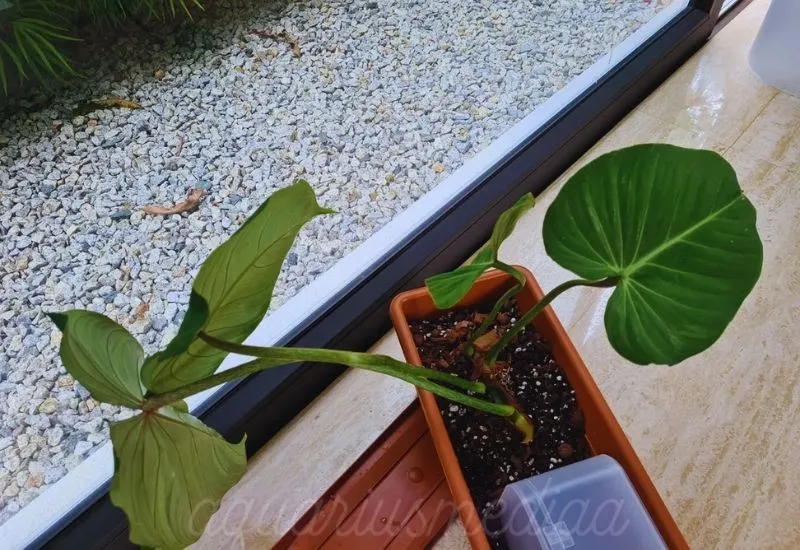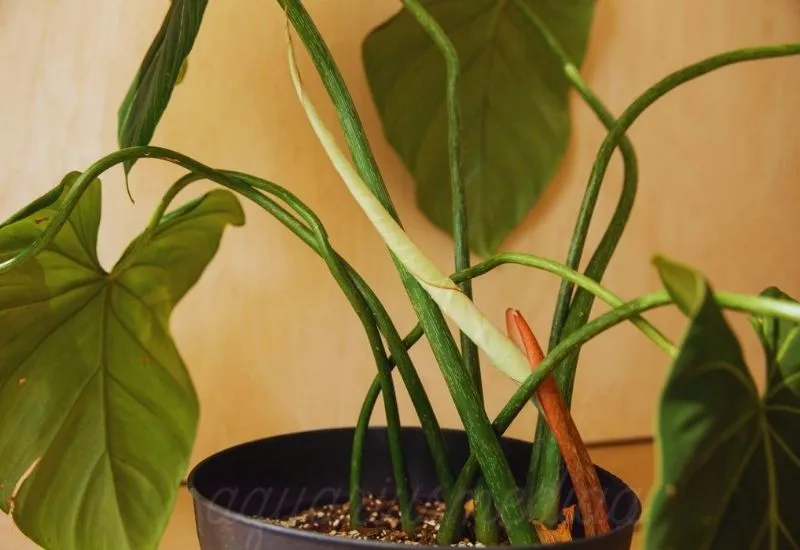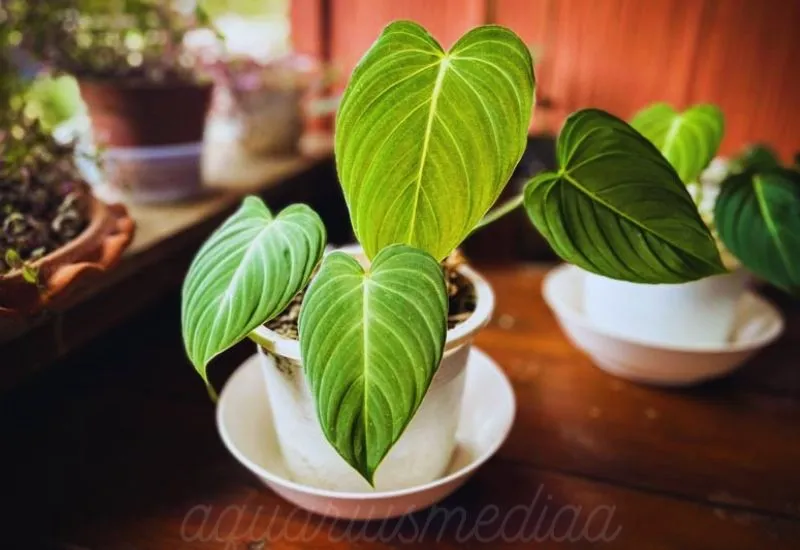In this blog post, you’re going to learn how to easily propagate and care for Philodendron gloriosum.
This is a comprehensive guide covering reliable information about different aspects of this variety.
In this post, I’ll cover:
- Interesting Facts
- Propagation
- Repotting
- Care
And
- Solutions to Common Problems
So, if you are looking to propagate and care for Philodendron gloriosum, this guide is for you.
Fun Facts
| Common Name | Anthurium Gloriosum, Velvet Philodendron, Creeper Plant |
| Botanical Name | Philodendron gloriosum |
| Family | Araceae |
| Plant Type | Perennial |
| Mature Size | Up to 90 cm |
| Sun Exposure | Bright but indirect sunlight |
| Soil Type | Acidic to basic |
| Soil pH | 5-8 |
| Native Area | Colombian rainforests |
| Toxic | Toxic for humans and pets |
| Growth | Medium growth |
Philodendron gloriosum, known as the creeper plant, is listed among the flowering plants. However, it is famous for its smooth but glossy-green large leaves. The distinctive feature of this household plant is the bright prominent white veins in its oversized leaves.
This small-sized plant doesn’t climb like other philodendrons. The Gloriosum is an aroid plant due to its velvety leaves and colorful blossoms.
Overall, the plant has a small size. It can reach up to three feet (90 cm). It flowers in the spring season outdoors, while indoor plants don’t mostly flower.
French Botanists discovered this plant in Colombia in 18761. This historical plant was transported to Europe and cultivated in several places. Even with widespread cultivation, it was included in the endangered species of plants. Nowadays, you can spot this plant in Southern Mexico, Venezuela, Ecuador, Peru, and Western Brazil.
Benefits
Philodendron gloriosum is a decorative piece in your house. It is a small plant that can fit in any garden, living room, and office space. This plant will clean and purify the internal air of your room. You will feel better to see the greenery in your house. Moreover, it is very easy to handle making it one of the best options for beginner plant keepers.
Propagation

Philodendron gloriosum is a slow-growing plant. So you have to wait for about two months for its first leaves to emerge. It can propagate through different ways. However, the most commonly used method is through stem cuttings.
- Take a sharp pair of scissors. Cut the stem between two nodes at an angle to increase the surface area. The cuttings should have two or three leaves.
- Wait for some hours to form a callus in that area.
- Then, put this cutting in a small water container. It will take up to two weeks to produce roots. During this time, you have to maintain cleanliness of water, warmth, and proper bright indirect sunlight.
- Now, using a pen, make a small hole in the soil mixture of the pot. Then, insert the cutting into that hole. You can dip that cutting in the growth hormone to increase its growth speed.
Make sure that the soil is loose to allow the newly growing roots to grow easily. Furthermore, maintain the soil’s moisture in the beginning.
Repotting

After every two to three years, you need to repot your Philodendron. If you want a confirmation sign for repotting, you can observe the roots sprouting from the holes of the pot. Furthermore, the growth of the plant slows down, and leaves start to shrink into smaller sizes. So now, it’s time to change the pot.
- The first step is to remove your plant from its previous pot. You can tilt the pot to pour the soil outside, and you can also use a knife to soften the soil around the plant.
- Then, gently pull the plant from the pot without damaging the roots.
- You can trim the dead or rotted roots from the plant.
- Now prepare a new pot about 3 inches larger in size. Then, hold the plant in the center of the pot and put the soil mixture in the pot surrounding the plant.
- In the first few days, you have to maintain moisture in the soil to let it settle down. After this, you can follow the previous routine.
Care
This tropical plant can adjust to hard conditions. However, it is recommended to keep it in mild temperatures and high humidity. This is a terrestrial plant, as it doesn’t need any support for growing. Moreover, its roots don’t go deep; they remain on the surface. This hardy plant is very easy to handle. You can easily maintain its growth in your house by following guidelines.
Pot
The size of the pot for this plant depends upon its age. For a small plant, you can use a 15cm diameter pot. When it matures, you can repot it with a two- to three-inch larger pot. However, the pot should be large enough that roots can spread comfortably.
This is a crawling plant, so it will need a shallow pot. Moreover, the pot must be porous for proper drainage. Clay pots are primarily used for this plant.
Soil

After you have selected a pot for your Gloriosum, the next step is to prepare the soil mixture. Before this, you have to consider the needs of this plant. It requires a balance between moist and dry soil. Therefore, you have to prepare a nutrient-rich organic soil that can retain moisture and drain the extra water simultaneously. You can add the following constituents to the potting soil to make it suitable for this plant.
- Peat moss will absorb water.
- Perlite will remove extra water through draining.
- Orchid bark will maintain aeration.
Light & Placement
This plant has large, soft, velvet leaves. These leaves cannot bear prolonged periods of direct sunlight. It will result in the leaf burns. At the same time, it requires sunlight for photosynthesis. So you have to find a place where it can receive bright but indirect sunlight.
If your room has east- and north-facing windows, place your plant in those spots. However, due to high humidity, plants show good growth in the kitchens and bathrooms.
Water
The frequency of watering changes with temperature and humidity levels. In summer, you have to water frequently. However, in winter, you should avoid frequent watering. According to experts, it is recommended that water only when the upper 3cm becomes dry. Moreover, you can check by touching the soil with your finger.
Fertilizer
Fertilizers keep the leaves of the Philodendron green and glossy. You have to provide proper nutrients along with other conditions. For this purpose, you can provide them with nitrogen-rich fertilizers. However, you should fertilize more frequently in the spring and summer and reduce the quantity in the autumn and winter.
Note
A rule of thumb is to spray liquid fertilizer once a month in spring and once every two months in autumn.
Temperature and Humidity
As these are tropical plants, they will need high temperatures and high humidity levels for proper growth. You should maintain a temperature above 55°F (12.7°C); otherwise, the plant’s tissues will be damaged. However, the ideal temperature range is 65 – 80°F (18 -27°C).
The ideal humidity level should be above 50%. You can maintain it in different ways, such as installing a humidifier or spraying water on it. Moreover, you can keep these plants in high-humidity places such as kitchens and bathrooms. Or cover it with a plastic to retain water and heat in it.
Pruning

In the case of most of the Philodendrons, you don’t have to prune the leaves. You should snip only yellow, brown, dead leaves. Moreover, cut the leaves slightly above the nodes. So that new leaves can grow.
However, if you want to prune the stems, cut only the longest stems to make them even with other branches.
Common Problems
Pests
There are a number of pests that can damage this Philodendron. That includes spider mites, thrips, mealybugs, armored scales, aphids, whiteflies, and fungus gnats, etc. Sick and stressed plants are more vulnerable to pests than healthy plants.
You can observe tiny dark spots due to the mealybugs, mostly on the underside of the leaves. Moreover, there will be stickiness, yellowing, and wilting of the leaves.
Aphids cause distortions in the growth. Sometimes, the leaves stop growing and start yellowing of the leaves.
Treatment of Pests
Pests are sometimes very difficult to remove. However, you can separate them from other plants and wash them with water. Moreover, you can treat them with insecticidal soap. However, dilute the soap solution to make it tolerable for the plant.
Alternatively, you can use neem oil to wash the infected part of the plant.
Fungal Diseases
The fungus can also cause black or brown spots on the leaves, which causes plants to wilt and die. Fungus develop on the plants’ leaves due to several reasons such as water logging, infected plant parts, and fungus from the soil mixture.
The first step in treating fungus diseases is to stop watering for a while. Then, you can repot the plant in a healthy soil mixture, and you can apply pesticides.
Brown Tips
Brown tips appear on the leaves before wilting. This is caused due to several reasons. Some of the most common are the following.
- Under watering
- Over-fertilizing
- Overwatering
- Inconsistent watering
If leaves are not dead yet, you can treat them by maintaining a regular watering routine.
Curling Leaves
Leaves of your Philodendron can curl for several reasons, such as lack of water, pest attack, high temperature, low temperature, direct sunlight, delay in repotting, poor fertilization etc. You can control all these factors to avoid curling of the leaves2.
Yellow Leaves
When the leaves of your Philodendron are turning yellow, it is a sign of watering issues. Mainly, yellowing of the leaves occurs due to the root rotting resulting from over-watering.
If it is due to overwatering, you can simply regulate your watering frequency to treat this issue.
Varieties & Similar Plants
You will see several varieties of Philodendron gloriosum. They have very minute differences in their leaves. These include the following.
- White veins
- Green veins
- Round form
- Dark form
- Pink back or white stripes
Philodendron Glorious
It is a hybrid species that results from the cross of Philodendron gloriosum and Philodendron Melanochrysum. It is similar to Philodendron gloriosum and has green velvety leaves, but it is differentiated due to its elongated structure.
Ready to Grab a Philodendron gloriosum to add beauty to your home garden?
All the above information is reliable, and you’ll see outstanding results if you want to grow or care for this plant.
Frequently Asked Questions
Article Sources
Aquariusmediaa provides reliable information with good-quality references to support the facts.
